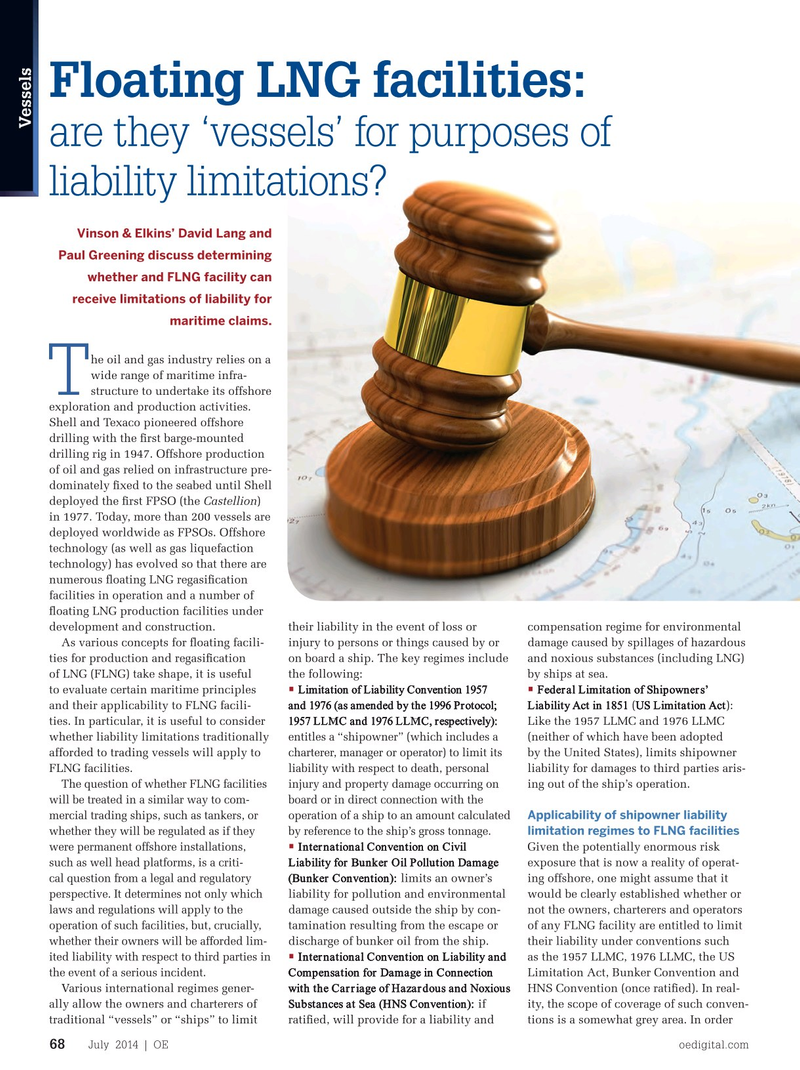
Page 66: of Offshore Engineer Magazine (Jul/Aug 2014)
Read this page in Pdf, Flash or Html5 edition of Jul/Aug 2014 Offshore Engineer Magazine
Floating LNG facilities:
Vessels are they ‘vessels’ for purposes of liability limitations?
Vinson & Elkins’ David Lang and
Paul Greening discuss determining whether and FLNG facility can receive limitations of liability for maritime claims. he oil and gas industry relies on a wide range of maritime infra-
T structure to undertake its offshore exploration and production activities.
Shell and Texaco pioneered offshore drilling with the frst barge-mounted drilling rig in 1947. Offshore production of oil and gas relied on infrastructure pre- dominately fxed to the seabed until Shell deployed the frst FPSO (the Castellion) in 1977. Today, more than 200 vessels are deployed worldwide as FPSOs. Offshore technology (as well as gas liquefaction technology) has evolved so that there are numerous foating LNG regasifcation facilities in operation and a number of foating LNG production facilities under compensation regime for environmental their liability in the event of loss or development and construction. to beneft from the liability limits set by damage caused by spillages of hazardous injury to persons or things caused by or As various concepts for foating facili- such conventions, the specifc facility in and noxious substances (including LNG) on board a ship. The key regimes include ties for production and regasifcation question would need to fall within the by ships at sea. the following: of LNG (FLNG) take shape, it is useful scope of the defnition of a “ship” (in
Federal Limitation of Shipowners’ to evaluate certain maritime principles the context of the LLMCs) or a “seagoing • • Limitation of Liability Convention 1957 and 1976 (as amended by the 1996 Protocol;
Liability Act in 1851 (US Limitation Act): and their applicability to FLNG facili- vessel” or “seaborne craft” (in the context 1957 LLMC and 1976 LLMC, respectively):
Like the 1957 LLMC and 1976 LLMC ties. In particular, it is useful to consider of the Bunker Convention and HNS entitles a “shipowner” (which includes a (neither of which have been adopted whether liability limitations traditionally Convention (once ratifed)) or a “vessel” by the United States), limits shipowner afforded to trading vessels will apply to (in the context of the US Limitation Act). charterer, manager or operator) to limit its liability with respect to death, personal
FLNG facilities. liability for damages to third parties aris-
The question of whether FLNG facilities injury and property damage occurring on
What constitutes a ing out of the ship’s operation.
“ship” or a “vessel”?
will be treated in a similar way to com- board or in direct connection with the
Applicability of shipowner liability The provisions of the LLMCs clearly mercial trading ships, such as tankers, or operation of a ship to an amount calculated limitation regimes to FLNG facilities indicate that the convention is intended whether they will be regulated as if they by reference to the ship’s gross tonnage.
• Given the potentially enormous risk International Convention on Civil to apply to all “ships” other than “drill- were permanent offshore installations, exposure that is now a reality of operat- Liability for Bunker Oil Pollution Damage ing ships or foating offshore platforms such as well head platforms, is a criti- ing offshore, one might assume that it (Bunker Convention): limits an owner’s connected to the seabed.” cal question from a legal and regulatory would be clearly established whether or liability for pollution and environmental To determine the applicability of the perspective. It determines not only which laws and regulations will apply to the not the owners, charterers and operators damage caused outside the ship by con- LLMCs to an FLNG facility, we must operation of such facilities, but, crucially, of any FLNG facility are entitled to limit tamination resulting from the escape or therefore determine that the facility is a whether their owners will be afforded lim- their liability under conventions such discharge of bunker oil from the ship. “ship” and that it is neither a “drilling • ited liability with respect to third parties in as the 1957 LLMC, 1976 LLMC, the US International Convention on Liability and ship” nor a “foating offshore platform the event of a serious incident.
Limitation Act, Bunker Convention and Compensation for Damage in Connection connected to the seabed.” While there
HNS Convention (once ratifed). In real- with the Carriage of Hazardous and Noxious Various international regimes gener- may be some interesting questions as to ity, the scope of coverage of such conven- Substances at Sea (HNS Convention): if ally allow the owners and charterers of whether a particular FLNG facility might tions is a somewhat grey area. In order ratifed, will provide for a liability and traditional “vessels” or “ships” to limit fall into the latter category, this article
July 2014 | OE oedigital.com 68 068_OE0714_Vessels2_VinsonElkins2.indd 68 6/20/14 7:19 PM

 65
65

 67
67